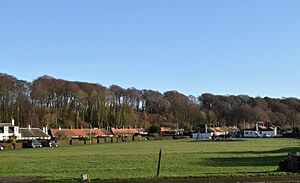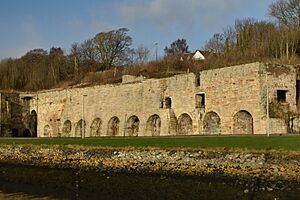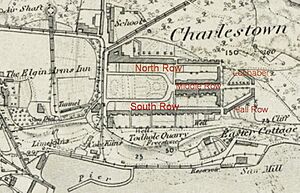Charlestown, Fife facts for kids
Charlestown is a small village in Fife, Scotland. It is also known as Charlestown-on-Forth. The village sits on the north shore of the Firth of Forth. It is about 1 kilometre (1 mile) west of Limekilns and 5 kilometres (3 miles) south-west of Dunfermline. Charlestown is famous for its old 18th-century lime kilns. It also has special Georgian-style houses that were built as part of a plan.
Contents
Village History
Charlestown was started in 1756 by Charles Bruce, 5th Earl of Elgin. The village was planned in a unique way. Its streets are shaped like the letters C and E. These letters stand for Charles Elgin, the founder's name.
The village was built as a port. Ships would carry coal from Lord Elgin's mines in Fife. It was also a place where lime was made. The outer part of the harbour was built around 1840. In 1887, a building called the Queen's Hall was built. This was to celebrate Queen Victoria's Golden Jubilee.
In the 1800s, ships were built and taken apart in Charlestown. After World War I, some ships from the German Imperial Fleet were brought here. They were taken apart for scrap metal.
Amazing Lime Kilns
Charlestown has fourteen huge lime kilns. They are made of cut sandstone and are very impressive. These kilns are seen as very important parts of Scotland's Industrial Revolution. They are even important for the whole United Kingdom. They are protected as Scottish Category A Listed buildings.
The kilns are built into the hillside below the village. They form a long stone wall, 110 metres (360 feet) long and 10 metres (33 feet) high. Most of the kilns are still in good condition. Many parts used to operate them are still there. Most of the kilns had their outer walls redone, probably in the 1800s.
Charles Bruce, the 5th Earl of Elgin, built these kilns. The first nine were built between 1777 and 1778. The last five were built in 1792. They were the biggest group of lime kilns in Scotland. They made one-third of all the lime produced in the country.
Lime was very important for farming. It helped improve the soil. It was also used in building. Lime was a key ingredient for mortar, plaster, and other building materials.
In the late 1700s and 1800s, the kilns were part of a big industrial area. This area also included coal mining, ironworking, and salt making. Coal and limestone came from local quarries on the Earl's land. The nearby harbour was also built by the Earl. It was used to transport lime products, limestone, and coal. There were local railway lines and a link to Dunfermline. Many other buildings were around the kilns, but most are now gone. The kilns stopped working in the 1930s and fully closed in 1956. The Broomhall Estate still owns the site.
The Planned Village Layout
Another special thing about Charlestown is its early planned layout. Charles Bruce, the 5th Earl, started it in 1756. The street pattern was supposedly designed to look like the letters C and E. These letters stood for Charles Elgin.
Charlestown was part of a movement in Scotland to create new villages. Between the mid-1700s and mid-1800s, about 500 planned villages were built. Charlestown was one of the first "industrial" villages in Scotland. Most other planned villages were for farming or fishing. Charlestown was different because it had homes for workers. It also had coal mining, limestone quarries, tramways, lime kilns, and a harbour. All these parts worked together.
Building of the first village started in 1756. It included areas like the North Row, South Row, Double Row, and also Hall Row and Lochaber to the east. The western parts of the North and South Rows face the village green. Most houses were finished by 1771. Some were not completed until the early 1800s. The houses were first single-story. They were built in groups of six. Some were later made into two-story homes. The Earl also built other buildings. These included Easter Cottage in 1760, a school in 1768, and the Sutlery (a stable and granary) in 1770.
Most of the houses are now Scottish B Grade Listed Buildings. They are part of the Charlestown Conservation Area. They were originally "estate" cottages, owned by the Broomhall Estate. After most of the industrial work stopped in 1935, many houses were sold to the people living in them. Some changes have been made to the houses over time. These include changes to doors, windows, and new additions at the back.
Village Paths
Some paths in Charlestown tell stories about the past. For example, "Shell Road" and "Lime Brae" show where these materials were carried. "Craw Road" and "Rocks Road" refer to birds and the ground surface. "The Run" was a path where extra water flowed from the upper village down to the sea.
Cricket Club
Charlestown is home to the Broomhall Cricket Club. It is named after Broomhall, Lord Elgin's nearby home. They have two main teams that play in the Scottish East League. This league is run by the East of Scotland Cricket Association. They also have junior, midweek, and Sunday teams. They play their games at The Cairns in Charlestown.
The Scottish Lime Centre
The Scottish Lime Centre Trust (SLCT) started in 1994. It was founded by Pat Gibbons, an architect who helped bring back the use of lime in building repairs in Scotland. She was the first Director. The current Director, Roz Artis, took over in 2005.
The Centre is in an old Charlestown building. It used to be the Estate workshop. The Centre is known around the world for its work. It teaches people how to use lime to repair and protect old buildings.
The main goals of the Trust are:
- To help with the proper repair of Scotland's old and historic buildings.
- To teach people about using lime for building repair and conservation. They offer advice, training, and hands-on experience.
- To help keep Scottish building traditions, crafts, and skills alive and growing.




